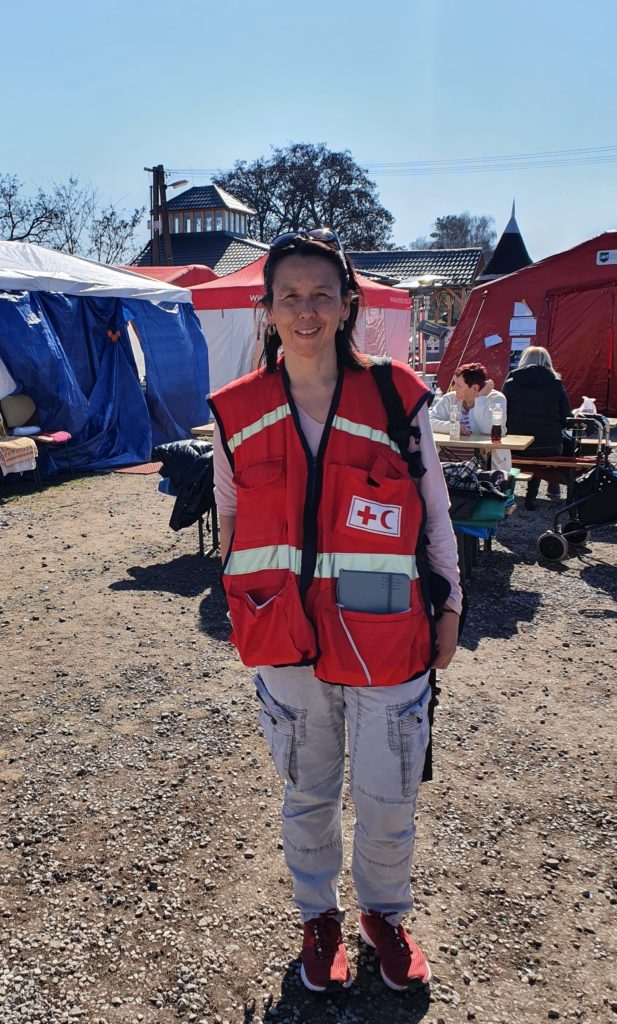The escalation of armed conflict in Ukraine on the 24 February 2022 led to a large humanitarian crisis which overflowed to neighbouring countries. Many people had to leave their homes and go to shelters and reception centres in search for safety. Community Engagement and Accountability Surge Officers went to help people fleeing their homes in this distressing situation.
Miki Tsukamoto worked as CEA Surge Officer in Slovakia during the first rotation of the emergency. As she was there, she visited the border areas and went to the reception centers to observe how people entered the country. She wanted to give them an opportunity to tell their own stories and made two participatory videos at the end of her stay. She tells us about the process, the challenges and what she learned. Especially how important it is to make sure that the person you talk to is okay with being interviewed and that you adopt a strict “do no harm” approach.

Participatory videos let you own your story
Participatory videos are films where the participants play an active role in the creation process. Miki stresses that to empower and raise a person’s voice, it is important to include them in designing, filming and editing their own videos. This ensures that the story is really owned by them. Different from a report, participatory videos also provide footage and live accounts which at times tend to capture audiences more than a static, written report. Participatory videos can also help the participant to process their own experiences and share them in an immediate way.
The ”Do No Harm” approach
But how do you approach a person in such a distressing and stressful situation? When Miki first visited a reception centre, she felt that she didn’t have the right to approach people crossing the boarders. She says that for anyone visiting the border points, it was evident that some of the people were traumatized and still trying to figure out where they would go and what they would do after fleeing their homes in Ukraine. When conducting this kind of participatory initiative, timing is key. This is why she only decided to carry out the project after having frequently visited and observed the three border areas and reception centres. At the time when she carried out the two participatory video initiatives it was close to the beginning of April, and displaced persons were staying longer at the reception centre.
Another important element is to ensure a “Do No Harm” approach. This means making sure not to approach anyone whose trauma risks being intensified through the process, or to exacerbate stress-levels. Participating in a video should be helpful and bring something to the participant. This means making sure that they want to do it; making sure of consent.
At both the reception centre and the temporary shelter making sure of consent involves carefully observing potential candidates before approaching them. For example, at the temporary shelter individuals and families are staying for differing amounts of time – they live in tents spread across the location. Many of these persons have been through a long wait at the border or have conducted a long journey, and that’s why it is important not to make the situation more exhausting. It is also important not to carry out the initiative right before departure.
Once someone had been identified, the small team of two people – Miki herself and her translator – approached them and thoroughly explained the participatory video initiative and, if they agreed to do the video, ask them to sign a written consent form in their local language. Only after this could the filming begin.
A small team of two with the help of National Society
It’s not easy to get in touch with people in distressing situations. Miki explains that it is important to make people feel at ease and to approach them in the language which is most comfortable for them. Therefore, she had the good fortune to be accompanied by an excellent Slovak Red Cross volunteer who spoke Ukrainian and Russian. She was also an excellent communicator when discussing with the displaced women. Support from the National Society (at the Headquarters and Branch level) was also essential; they provided the background information and contacts needed to approach people at the reception centres.
Location: A reception center at the beginning of an emergency
Miki has carried out many participatory video processes in various locations in the past. But she says that it was in many ways a different experience this time.
In general, she has always kept a strict community-based approach. This means entering the community first, spending time and working with the representative groups, and only then – with a strong understanding of the community- carry out the filming. But as it was the first month of an emergency operation, and the fact that the people were passing by on their way to somewhere else, it was not possible this time.
Registration centres are busy locations and in view of the conflict, the long journey and at times separation from family(ies), emotions and stress levels could be high. It was important to be aware of this when deciding on the appropriate time to carry out the activity. Having someone who could speak the local languages as an interpreter was also essential in helping putting people at ease.
Key take–aways
Miki’s key take aways from this experience are the importance to be flexible and ready to adapt to the evolving emergency context. Prioritize your activities and time them, so you can have a meaningful impact and respect a “Do No Harm” approach.
And most importantly: Listen and Learn!
This article was written by IFRC’s Miki Tsukamoto (CEA Surge Officer) and Minna Guigon-Sell (CEA Communications Consultant)
Discover participatory video resources, including templates and videos, here.
